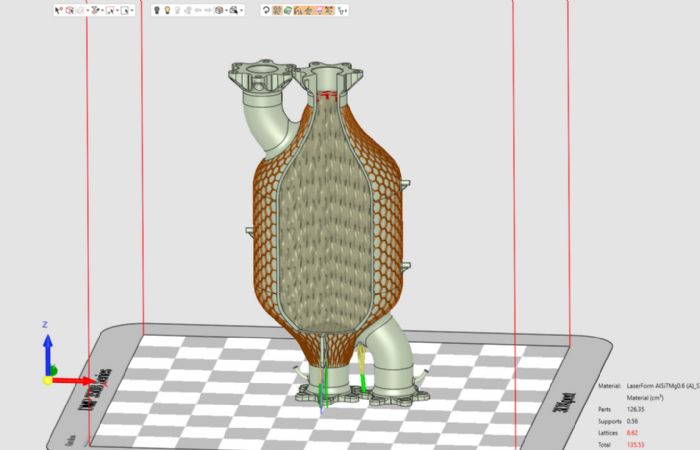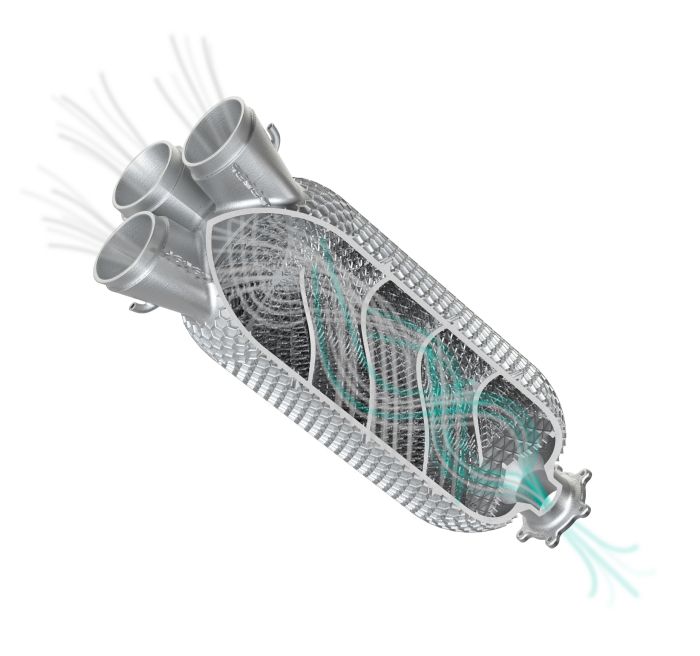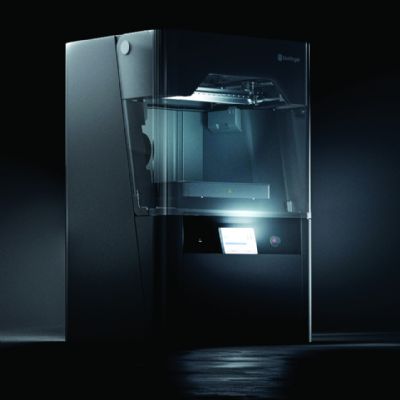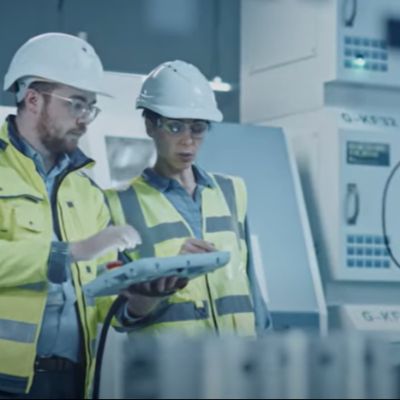Some of these benefits:
- Design optimization for energy efficiency—When we direct the design-optimization capability of AM toward these carbon capture and utilization systems, we have the potential to dramatically boost performance and efficiency, approaching lossless energy.
- Design freedom—AM enables freedom of design to express the novel architecture required to efficiently capture and process carbon from the atmosphere, and do something useful with it.
- Performance—AM can produce parts from a range of high-temperature, corrosion-resistant alloys that possess high thermal conductivity.
- Scalability—Rapidly available via scalable manufacturing, AM can support the massive need in the field for equipment.
- Supply-chain efficiencies —AM provides for part consolidation and monolithic design, allowing for streamlining of the supply chain. We cannot overlook the carbon footprint of using multiple suppliers across the country to produce a single assembly.
AM satisfies all of the requirements for the production of DAC components and enables applications that address a variety of needs for carbon capture.
Microturbine Equipment
 Microturbines, emerging in various industries including power generation, present an opportunity to provide high-pressure, high-efficiency gas and fluid conveyance in a small form factor, with a minimal energy/carbon footprint. Efficiency in carbon capture, much like in power generation, is a function of yield over energy input.
Microturbines, emerging in various industries including power generation, present an opportunity to provide high-pressure, high-efficiency gas and fluid conveyance in a small form factor, with a minimal energy/carbon footprint. Efficiency in carbon capture, much like in power generation, is a function of yield over energy input.
High-performance, reliable air compression and system-pressure stability are critical to the function of carbon-capture systems. As industrial carbon-capture systems trend toward more commercial units with distributed production and operation, it’s even more critical to make use of novel, compact turbine technology that enables high-efficiency, small-footprint operation.
Mechanical Filters
A critical component of carbon capture involves “catching” the carbon in the first place with a structured mechanical filter, typically coated with an amine that attracts carbon. Air is drawn into the system through the first stage, or the direct-air-contact stage.
Direct-air-contact filter efficiency can be maximized by filter structures that allow for maximum contact between incoming air and the filter surface. AM allows for the function-first design of such filters (Fig. 1), which can induce high levels of turbulence and mixing as well as high surface area for maximum air contact. The challenge: How do we create the maximum amount of surface area with the least pressure drop?
Heat Exchangers
A common problem in carbon capture: heat waste. Carbon captured in the first direct-air-contact stage must be evacuated from mechanical filters into downstream refinement stages. Often, this occurs via pressurized steam liberating the carbon from the filter. Heat exchangers can be applied to eliminate surplus heat from the steam-generation process, and more commonly downstream to reduce the temperature of carbon-rich steam that exits the filter stage. Furthermore, novel heat-exchange strategies such as design of exchangers for AM production (Fig. 2), couple with downstream distillation and refinement steps to keep the process at a stable temperature in order to sustain a chemical reaction and produce output carbon product.
Diffuser Plates
Diffuser plates, commonly applied in chemical processing, take and collimate, or align, some volume of gas or fluid. Fluid diffusion works similarly to the concept of light collimation, which takes a light source and organizes the energy so that light emits diffusely with parallel beam paths. Diffusor plates operate similarly to a garden-hose spray nozzle that turns a chaotic fluid flow into a structured and even flow. Liquid diffuser plates, important components of process stacks, ensure uniform flow and treatment of carbon-rich fluid as it flows through the process.
AM allows for large-volume diffusor plates to provide high-efficiency fluid diffusion primarily by enabling design complexity in diffusor-plate and diffusor-nozzle shape. Borrowing concepts from aerospace fuel-nozzle design and semiconductor and capital-equipment showerhead applications, AM diffusor plates can be manufactured 20 times faster than via machining alone.
Chillers and Distillers
The carbon-rich product exiting the filter stage can be considered “dirty” and in need of further processing. This dirty-carbon post-processing can be accomplished outside of a self-contained system, but it implies the production of even more carbon in the logistics of collecting and transporting dirty-carbon product to secondary post-processing facilities. The most valuable and promising carbon-capture systems have some level of integrated dirty-carbon-product post-processing such that the output of a carbon-capture system consists of clean usable carbon product, and safe water-based byproduct.
Refinement columns, including distillers with integrated chilling as well as heat exchangers, are relatively complex to assemble traditionally, featuring dozens of sheet metal shells and stages, possibly hundreds of yards of bent tube, and dozens of machined or cast flanges, fittings and manifolds. All of this must be procured and assembled, which further increases the collective carbon output and pollution caused by merely manufacturing and assembling the components.
AM allows for extensive part consolidation and monolithic design, which enables significant consolidation and streamlining of the supply chain. It also enables a function-first, highly efficient design that can accelerate the refinement stage, providing even more output in a smaller form factor.
Manifolds—Liquid, Gas and Vapor
Carbon capture involves fluid and gas combined with chemistry, temperature and pressure. Manifold applications in carbon capture are numerous, ranging from chemistry conveyance into process chambers to efficient distribution of coolant to active cooling components such as heat exchangers, as well as general gas-distribution applications. What makes these components challenging to produce is not the requirement for chemical resistance or aerospace-grade special materials, but rather the need for balanced pressure across many branching lines, and even delivery of fluids through a process chamber. Efficient one-to-many branching with even fluid flow, combined with space and assembly restrictions, represents a geometry problem that AM is uniquely positioned to enable, as evidenced by its adoption in aerospace, defense and semiconductor capital equipment.
A Future Where We Can Breathe Easier
AM enables significant efficiency advances in direct air capture and refinement, a critical technology for correcting atmospheric carbon levels. For their parts, 3D Systems and AirCapture report great strides in their collaboration by utilizing AM to quickly iterate and manufacture production-ready components. They’ve reported the ability to apply never-before-used high-efficiency geometry to process stacks and thermal exchange that enable increased capture efficiency while reducing form factor and footprint, making the technology easy to install and, ultimately, scale. With further adoption of advanced-manufacturing technology and design tools, we see the possibility of a comfortable and livable climate for future generations. 3DMP
See also: 3D Systems
Technologies:
 Scott Green
Scott Green Matt Atwood
Matt Atwood Some relatively simple chemical reactions lie at the heart of carbon capture. Any system for carbon capture and reclamation must operate at extreme efficiency to ensure that it does not add to the problem by consuming carbon-heavy fuels or emitting more carbon into the atmosphere. In other words, we must capture as much carbon as possible while using significantly less carbon than we capture to produce the reaction. Ideally, the goal is zero carbon input for unlimited carbon reclaimed as output.
Some relatively simple chemical reactions lie at the heart of carbon capture. Any system for carbon capture and reclamation must operate at extreme efficiency to ensure that it does not add to the problem by consuming carbon-heavy fuels or emitting more carbon into the atmosphere. In other words, we must capture as much carbon as possible while using significantly less carbon than we capture to produce the reaction. Ideally, the goal is zero carbon input for unlimited carbon reclaimed as output. 





 Microturbines, emerging in various industries including power generation, present an opportunity to provide high-pressure, high-efficiency gas and fluid conveyance in a small form factor, with a minimal energy/carbon footprint. Efficiency in carbon capture, much like in power generation, is a function of yield over energy input.
Microturbines, emerging in various industries including power generation, present an opportunity to provide high-pressure, high-efficiency gas and fluid conveyance in a small form factor, with a minimal energy/carbon footprint. Efficiency in carbon capture, much like in power generation, is a function of yield over energy input. 

